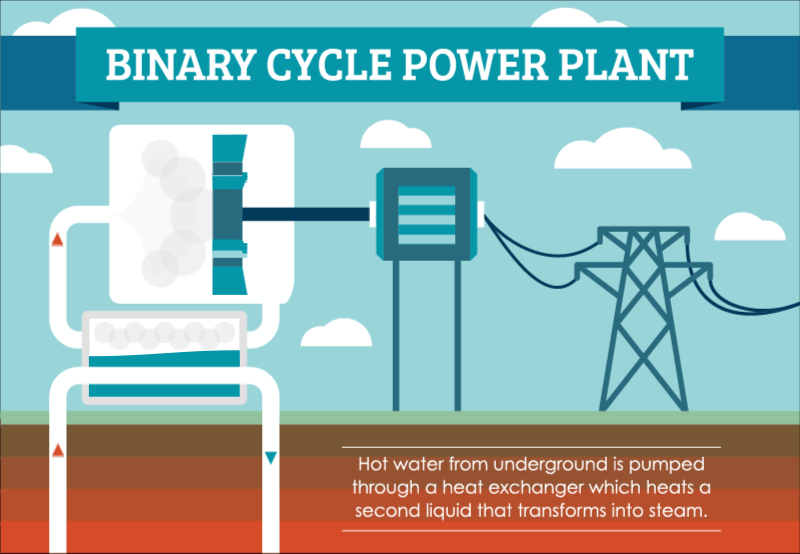
Best-Kept Secrets of Conventional Geothermal Energy
Conventional geothermal processes can maximize low-temperature heat usage to support other industries, like agriculture.
Terrapin • April 7, 2021
3 minute read
On March 11, we announced that our recent temperature log confirmed subsurface temperatures sufficient for generating geothermal electrical power generation in Alberta. We were encouraged to hear the enthusiasm this log created in opening the next chapter of Alberta’s energy industry. Moving forward, we realize that more needs to be done to explain how our Alberta No. 1 geothermal energy project differs from what you may see in a residential area. It is in these differences where you can find conventional geothermal energy's best-kept secret: the value of geothermal heat beyond power generation potential.

4 MW geothermal power plant in Pico Alto.
(Photo: Exergy International)
Geothermal Energy Systems vs. Geo-Exchange Systems
When “geothermal energy” is used to heat one’s home or urban area, these communities are likely using a type of geo-exchange system. Geo-exchange, or ground-source heat pumps (GHPs), is a renewable energy system that uses the seasonal temperature differences and the space it is heating or cooling to drive the heat transfer. This technology does not generate power nor produce hot brines for geothermal heating, but instead uses the shallow subsurface like a battery. These geo-exchange systems store heat in the summer and release it in the winter.

A geo-exchange system provides heat in the winter and cooling in the summer.
(Diagram: Terrapin Geothermics)
Geo-exchange systems rely on shallow, low-temperature sources, such as lakes or the ground two to 100 metres below surface, as the heat source and heat sink. This shallow thermal energy comes from solar radiation – heat from the sun’s rays – instead of the heat derived from the sub-surface of the Earth. In the cold winter months, when the lake or ground below is warmer than the surface, the lake or ground acts as a heat source. A heat pump extracts this thermal energy to heat the building where it is installed. In the warm summer months, when the surface is warmer than the ground below, the process is reversed and the lake or ground acts as a heat sink.


The heat source for a geo-exchange system is the sun (left). The heat source for deep geothermal energy is the earth's internal heat (right).
(Diagrams: Terrapin Geothermics, Shutterstock)
How is Geothermal Energy Produced
On the other hand, the Alberta No. 1 geothermal energy project is a deep conventional geothermal project, and more specifically, a binary power plant. This geothermal energy sources heat from the natural occurring thermal energy of the earth and involves drilling up to four kilometres below ground to reach hot brine reservoirs greater than 100°C. The hot brine is brought to surface, where the heat is extracted by a heat exchanger and the energy transferred to another “working fluid”. Within this geothermal technology, the heat is transferred to a working fluid to produce vapour. This vapour, in turn, drives an Organic Rankine Cycle (ORC) turbine to generate electricity. The use of the two fluids (geothermal brine and working fluid) is what gives this type of power generation its binary name.

Geo-exchange systems use different technologies and sources to capture thermal energy.
(Diagram: Save On Energy)

Conventional geothermal power generation can use a binary cycle system.
(Diagram: Save On Energy)
Geothermal Energy Uses
With conventional geothermal energy production, the hot brines that are brought to surface are not only useful for electricity, but also the heat energy can be used for other purposes. Geothermal energy’s best-kept secret is that the sources with temperatures ranging from 40°C to 100°C, which are not efficient for electrical production, are perfectly suited for other uses of geothermal energy. This geothermal energy production can provide constant, emission-free heat on a utility scale, supporting industries like tourism, agriculture, and manufacturing. When the temperature of the brine is above 100°C, electricity can also be produced. After the electricity is generated, residual heat can be used for other purposes.
Alberta No. 1, for example, is expected to produce 985 TJ/year of thermal energy. This heat can be distributed to facilities that require large amounts of consistent, lower temperature heat, such as commercial greenhouses, timber kilns, and grain dryers. This heat can also be utilized to melt snow in parking lots and highway intersections. By utilizing the clean heat directly, instead of using natural gas fired boilers or electricity, these facilities and industries can reduce their energy costs and generate carbon offsets.
.png)
Grain drying costs vary from year to year as energy costs fluctuate. Dryers can increase their energy cost certainty and reduce carbon emissions if operations used geothermal heat rather than fossil fuels.
(Photo: Getty Images)
Considering how over 60% of Canada’s energy needs are for space heating, geothermal energy’s economic and environmental value lies in its ability to provide constant, emission-free heat to the industries, homes and commercial facilities that need it.
Help Us Advance Geothermal Energy
Terrapin is excited to be developing Alberta's first conventional geothermal energy facility and advancing the geothermal industry in Canada through the Alberta No. 1 project. Learn how you can lead the next chapter of Alberta's energy story by talking geothermal energy projects with us! You can also view one of our recent webinars for the latest up to date information on geothermal energy development!
